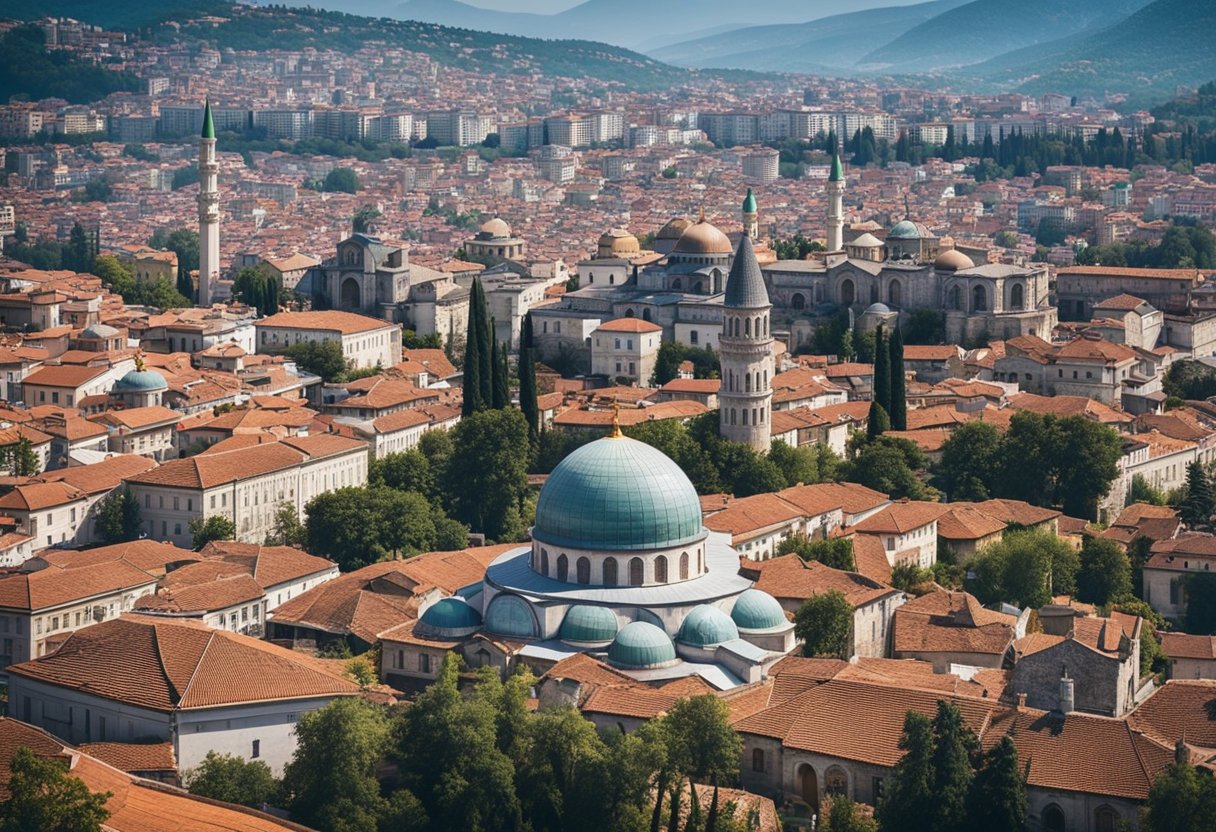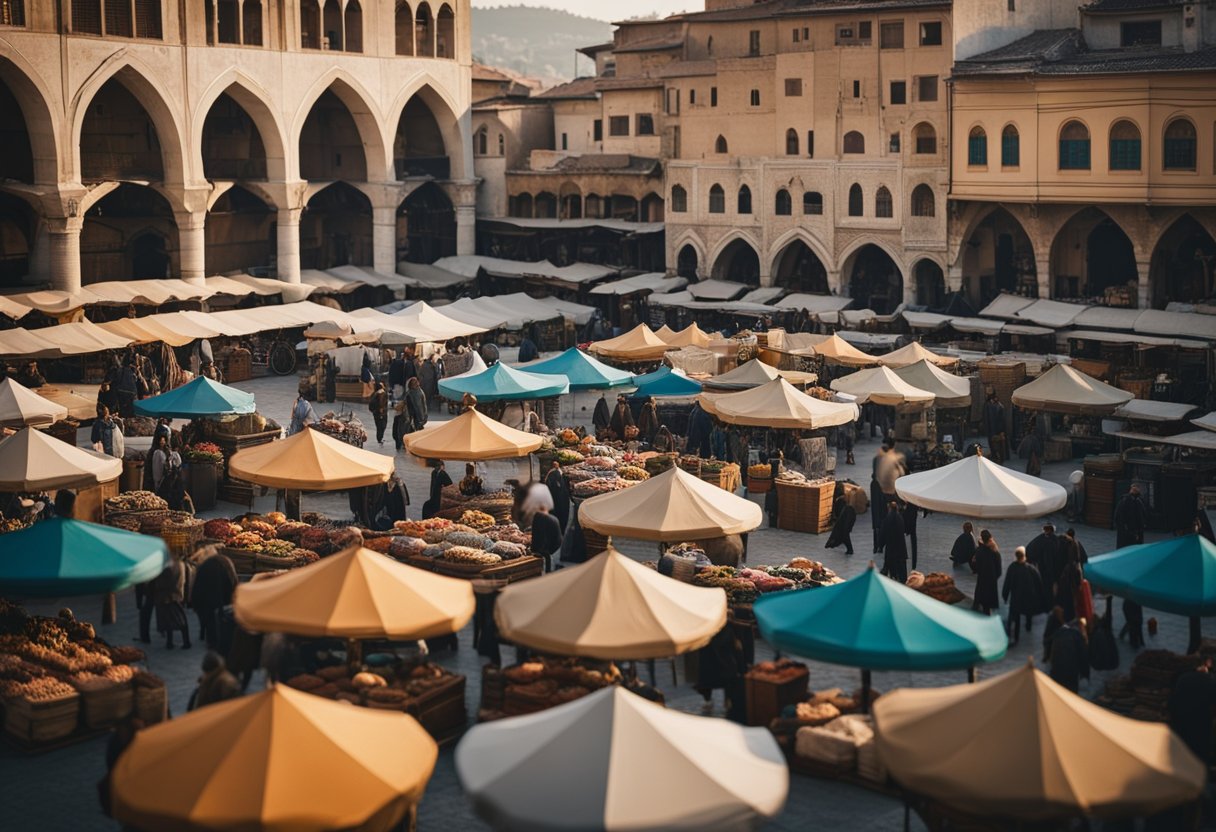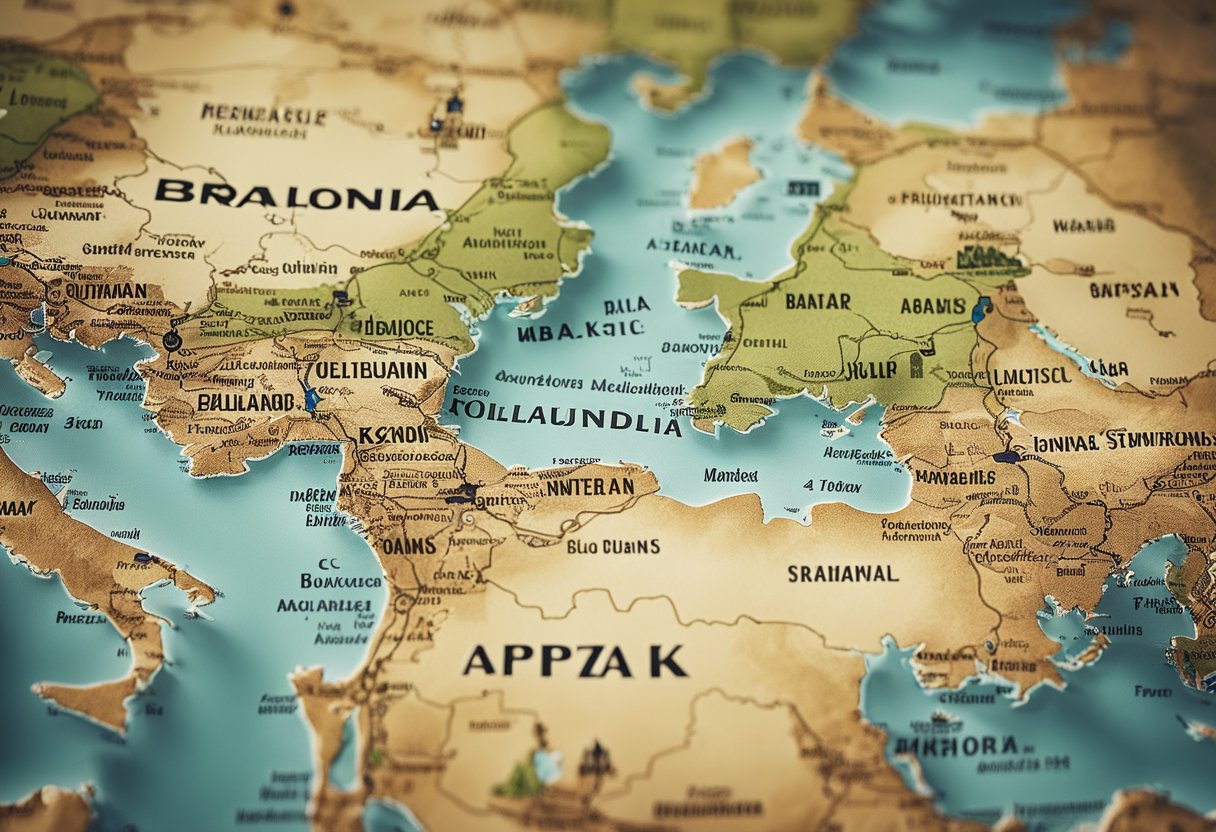The Ottoman Influence: Explore the Empire’s Enduring Magical Legacy in Balkan History

Updated On: April 22, 2024 by Fatma Mohamed
Tracing the legacy of the Ottoman Empire in the Balkans reveals a complex tapestry of historical influence that still resonates in the region today. Our exploration begins with the onset of Ottoman rule and stretches through the Empire’s eventual decline. As the Ottomans established dominion over southeastern Europe, their presence reshaped the political, cultural, and economic landscapes of the Balkans. This era left behind a myriad of vestiges, from architectural landmarks to linguistic traces, that speak of the intricate interweaving of empires.

Our journey through history highlights the palpable remnants of Ottoman influence in the Balkans. The interplay between the dominion and the local populace produced a milieu where religions and cultures coexisted, clashed, and ultimately contributed to the sociocultural evolution of the region. While the Ottoman Empire has long receded into the annals of history, its echo still lingers in the bustling bazaars, the minarets stretching towards the sky, and the culinary traditions savoured across the Balkans. We must consider both the legacies cherished and the challenges faced by contemporary Balkan societies in the shadow of an empire that once connected the East and West.
Table of Contents
The Rise of the Ottoman Empire
The Ottoman Empire’s ascension marked a turning point in the history of South-Eastern Europe. Our section will explore the critical stages of the Empire’s expansion and its profound impact on the region, particularly by examining its aggressive conquests and the historic fall of Constantinople.
Conquest and Expansion
The early stages of the Ottoman Empire’s rise were characterised by strategic military conquests and political alliances. Osman I laid the foundations in the late 13th and early 14th centuries, targeting weakened Byzantine holdings in Western Anatolia. The empire’s hegemony grew as it absorbed other Turkish principalities and former Byzantine territories, making the Ottomans a formidable power in the region.
Remarkably, the capture of key cities facilitated their expansion; notable victories included the Battle of Bapheus in 1302 and the seizure of Bursa in 1326. These conquests were motivated by the empire’s state structure and the Ghazi ethos, which championed the fight against non-Muslims, lending a religious fervour to their campaigns.
The Capture of Constantinople

The fall of Constantinople in 1453 was a significant milestone for the Ottoman Empire and a tragic blow to the Byzantine Empire. Sultan Mehmed II, often known as Mehmed the Conqueror, led an extensive siege that lasted 53 days, employing a combination of large cannons and naval blockades. The Ottomans succeeded in breaching the previously impregnable walls of Constantinople, not only due to their formidable military tactics but also thanks to their strategic use of technology and dedicated troops.
The fall of Constantinople reverberated throughout Christendom, marking an end to the Byzantine Empire and cementing the Ottomans’ control over the remnants of the Roman Empire in the east. It effectively shifted the centre of the Ottoman Empire to this strategically vital city, opening up new paths for expansion into Europe and transforming Istanbul into a thriving capital of political, economic, and cultural significance.
Ottoman Rule in the Balkans
As we examine the Ottoman rule in the Balkans, we find a complex administrative structure and a unique religious system that defined the empire’s governance of this diverse region.
Administrative Structure
The Ottomans established a sophisticated administrative system to manage the lands they controlled. This structure was hierarchical, with the Sultan at the apex, governing through a centralised bureaucracy that extended into the Balkans. Regional governors, known as Beylerbeyis, oversaw large provinces called Eyalets, which were further divided into smaller districts known as Sanzaks. This system allowed for efficient governance and resource extraction, maintaining stability within the empire for centuries.
The Millet System
The Millet system was an innovative approach to managing the diverse religious communities under Ottoman rule. It allowed religious minorities such as Orthodox Christians, Jews, and various Islamic sects to govern themselves according to their own laws in matters of personal status and family law, led by their religious leaders. Specifically, in the Balkans, the system provided a measure of autonomy to the Orthodox and other Christian communities whilst ensuring loyalty to the Ottoman sultan. Under the Millet system, the non-Muslims were also known as dhimmis, a status that permitted them to practice their religion in exchange for a special tax known as jizya.
Through these governance methods, the Ottomans were able to maintain control over the Balkans, shaping the region’s socio-political landscape that carries vestiges of this legacy to this day.
Cultural and Religious Influence
The Ottoman Empire’s tenure in the Balkans introduced profound changes, leaving a collage of cultural and religious imprints. Our focus highlights these areas, centring on Islam’s introduction, the endurance of Orthodox Christianity, and the resulting cultural symbiosis.
Spread of Islam
With the Ottoman conquests, Islam found fertile ground in the Balkans, a region that embraced various customs and beliefs. Local populations encountered Islamic traditions and religious practices, which took hold, especially in areas like Bosnia and Herzegovina, Albania, and Kosovo. Through mosques, educational institutions, and sociopolitical systems, Islam profoundly shaped the societal landscape of the Ottoman Balkans.
Orthodox Christianity and the Church
Despite the spread of Islam, Orthodox Christianity not only persisted but also reinforced its presence in the Balkans. The Ottoman authorities recognised the Orthodox Church as a millet, an autonomous community, which allowed it to maintain its religious activities and instil a sense of continuity amid the overarching Islamic rule. This endurance symbolised the religious diversity that characterized the empire and the Balkans.
Syncretism and Cultural Exchange
The intersection of Islam and Orthodox Christianity, accompanied by pre-existing traditions, fostered a rich cultural exchange and syncretism. In areas where people of different religions coexisted, unique forms of cultural interweaving emerged, blending architectural styles, languages, and culinary traditions, among other aspects. The result was a distinct cultural tapestry that continued to shape the identity of the Balkan peoples long after the empire’s dissolution.
Economic Impact and Land Administration

The Ottoman Empire’s influence in the Balkans has had a profound effect on the region’s economic and land administration systems. Historical records detail how land allocation and taxation policies imposed by the Ottomans have shaped the agricultural and commercial practices that persist today.
Agriculture and Taxation
The Balkan lands, fertile and diverse, were central to the Ottoman agricultural system, with peasants working the land under various forms of tenure. The empire implemented a tax system called cizye, which was a levy on non-Muslims, and a land tax known as tımar that funded the military and administrative apparatus. Agrarian production and taxation were closely tied, and the bulk of this revenue came from the peasants who cultivated the fields.
Trade and Commerce
Trade networks throughout the empire included the Balkan regions, where commercial activities flourished under Ottoman patronage. Key trade hubs emerged, facilitating the exchange of goods between the East and West. The Ottomans encouraged the development of guilds and commerce, which led to significant urban growth and the rise of prominent market towns. Ottoman commercial codes and regulations were enforced to sustain the flow of trade and to ensure tax revenue, vital for the empire’s economic stability.
Through our meticulous examination of historical patterns, we can trace the enduring legacy of the Ottoman Empire in land administration and economic influence in the Balkans.
Nationalism and the Struggle for Independence
The collapse of the Ottoman Empire served as a catalyst for nationalism, fuelling movements and uprisings across the Balkans that sought to establish independent nation-states.
Serbian Uprising
The first notable upsurge of Balkan nationalism began with the Serbian Uprising (1804–1817). We observe the Serbs coalescing to throw off the Ottoman yoke, a struggle that ultimately set a precedent for Balkan independence. The leadership of figures like Karađorđe marked a turning point, not only for Serbia but for the collective consciousness of the Balkans.
Greek War of Independence
Similarly, the Greek War of Independence (1821–1829) saw an outpouring of Hellenic national identity and a fierce desire for self-determination. The Philhellenism movement garnered significant international support, leading to the eventual recognition of Greece as an independent state. This war underscored the importance of nationalism in the fight for sovereignty.
Balkan Wars and Formation of Balkan States
The Balkan Wars (1912–1913) were instrumental in carving out the contemporary Balkan states map, each driven by ambitions of expansion and autonomy. The cessation of hostilities left countries like Bulgaria with a strong sense of national identity, having experienced both the camaraderie and conflict that came with asserting independence amidst a decaying empire.
The Decline and Retreat of the Ottoman Empire
In the fabric of Balkan history, the Ottoman Empire’s withdrawal marks a period of significant transformation. After reaching the pinnacle of its power, the empire faced a series of challenges that led to the loss of territories and necessitated internal reforms.
Loss of Territories
The Ottoman Empire, entangled in a complex web of challenges, began to cede ground to the Austrians and Hungarians, among others. Key battles, such as the Battle of Vienna in 1683, signalled the empire’s weakening grip on its European lands. The retreat became a steady erosion of influence and control as territories that were once firmly under Ottoman rule slipped from their grasp.
Internal Factors and Reforms
One can attribute the empire’s decline not only to military defeats but also to internal strife and ineffective governance. Attempts at reform, including the Tanzimat reforms, aimed to modernize the empire’s structures and regain its former strength. However, these reforms might have arrived too late and were met with resistance within the empire, further exacerbating its vulnerabilities and accelerating its retreat.
The First World War and Its Aftermath
We’ll explore the critical role of the Ottoman Empire during the First World War and the sweeping changes that followed its collapse, focusing on the Balkan States and the pivotal Treaty of Sèvres.
Ottoman Involvement
As the First World War erupted, the Ottoman Empire found itself in a precarious alliance with the Central Powers despite its declining power. The Balkan States, situated at the empire’s European border, became a tumultuous theatre of conflict where the Ottomans strived to maintain influence. Despite initial successes, the tide of war eventually turned against the Ottoman forces, setting the stage for dramatic repercussions in the region.
Dissolution and Treaty of Sèvres
After the armistice, the once-mighty Ottoman Empire faced its final chapter. The Treaty of Sèvres, signed in 1920, carved the empire into several nation-states, significantly reshaping the geopolitical landscape of the Balkans and the Middle East. This treaty outlined bold new borders and instigated the creation of modern nations from Ottoman territories, forever altering the destiny of the Balkan states.
The Rise of Modern States

As the Ottoman Empire receded, the modern nation-states of Türkiye and the Balkans emerged, shaping the geo-political contours of Southeast Europe and Western Asia.
Establishment of the Republic of Türkiye
Following the collapse of the Ottoman Empire after World War I, Türkiye redefined itself as the Republic of Türkiye under the leadership of Mustafa Kemal Atatürk. Atatürk’s reforms laid the foundation for a secular and modern state, with Kemalism advocating for sweeping changes across the legal, political, economic, and cultural spheres. The new Türkiye was officially proclaimed on 29 October 1923, and Ankara became its capital.
Post-Ottoman Balkan Nations
Elsewhere, the vacuum left by the Ottoman retreat saw the rise of new, independent states across the Balkan countries. These nations forged identities often reflected by their struggles for autonomy and, later, through the conflicts of the 20th century. The Balkans, an intricate tapestry of cultures and religions, carry the Ottoman heritage into the modern era, with each state navigating its unique path towards establishing a defined national identity within a post-Ottoman and often post-communist context.
Ottoman Legacy in Contemporary Balkan Societies

The Ottoman Empire’s centuries-long dominion over the Balkans has left indelible marks that continue to shape the region’s societal and cultural contours today.
Muslim Communities Today
In the contemporary Balkans, Muslim communities exhibit a rich tapestry of traditions stemming from their Ottoman past. The influence persists in language, religious practices, and cuisine, resonating with the echoes of historical ties. For example, the architectural landscape across the Balkans still prominently displays minarets and Ottoman-influenced design, a testament to the empire’s lasting legacy in the region.
The Ongoing Cultural Influence
Beyond the clearly visible markers like architecture, the Ottoman legacy weaves through the intangible cultural threads of the Balkans. Music, dance, and folk art carry Ottoman influences, blending seamlessly with local traditions to create unique cultural expressions. Our understanding of the Balkans’ social and cultural milieu is enriched by acknowledging the interplay between these regional cultures and their Ottoman heritage.
Challenges in the Post-Ottoman Era

In the aftermath of the Ottoman Empire’s decline, the Balkans faced a complex web of difficulties, particularly regarding ethnic relations and international diplomacy. Our focus on these issues reflects their profound impact on the region’s stability and progress.
Ethnic Tensions and Conflicts
The fall of the Ottoman Empire left a mosaic of diverse ethnic groups grappling for identity and political authority. Disputes over territory and power often escalated into violence and conflict, with historical grievances resurfacing in a volatile geopolitical landscape. The rekindling of ancient animosities created a precarious environment, further complicating the already delicate task of nation-building and governance.
Western Influence and Foreign Policy
The vacuum of power in the Balkans also attracted the interests of the Western world, shaping the region’s foreign policy in many ways. We witnessed the adoption of political systems and ideologies from Western Europe and North America, which did not always resonate with local traditions and perspectives. Balancing modernisation with historical and cultural integrity proved to be a Herculean task, often leading to a complex tug-of-war between advancing Western influence and preserving indigenous Balkan identities.
The Ottoman Empire in the Geopolitical Landscape

As we explore the historical significance of the Ottoman Empire in Southeastern Europe, we notice the profound impact and lasting influence on current international relations.
Ottoman Impact on Southeastern Europe
The Ottoman Empire’s rule over Southeastern Europe reshaped the region’s geopolitical landscape. Through strategic marriages, military conquests, and alliances, the Ottomans extended their influence well into the Balkans. Key cities and trade routes fell under their control, leading to a significant shift in power dynamics within the region. This expansion facilitated the spread of Ottoman cultural influences, administrative practices, and legal structures, which are still evident in the policies and social norms of some Southeastern European states.
Influence on Current International Relations
The legacy of the Ottoman Empire remains a factor in contemporary international relations, particularly within multinational alliances such as NATO. Although the empire dissolved in the early 20th century, the cultural and political borders that it left behind continue to affect present-day diplomacy and security strategies in the region. For instance, conflicts in areas such as the Balkans during the late 20th century reflected historical divisions established during Ottoman rule. As a result, NATO operations and peacekeeping efforts have had to navigate a complex tapestry of ethnic and religious identities partially shaped by the Ottomans.
Our investigation underscores how the echoes of the empire are still present in the geopolitical realities of Southeastern Europe and beyond.
Frequently Asked Questions
We now explore several commonly posed queries regarding the legacy of the Ottoman Empire in the Balkan region. Our aim is to provide clear and precise answers based on historical records and analyses.
What enduring impacts did the Ottoman Empire have on the cultures of Balkan states?
The Ottoman Empire significantly influenced the cultural tapestry of the Balkans, most notably through the diffusion of Islamic religion, crafts, and customs that remain evident today. Local languages also borrowed many Turkish words, and a blend of Eastern and European traditions became a hallmark of the region’s diverse identity.
In what ways did the administrative practices of the Ottomans shape the political landscape of the Balkans?
Ottoman administrative practices introduced a complex system of governance involving military districts known as the ‘Sanjak’ and the ‘Millet’ system, which allowed a certain degree of autonomy based on religious communities. This legacy persisted past the empire’s decline, impacting the political frameworks and ethnic relations in the Balkans.
How did the religious landscape of the Balkans change as a result of Ottoman rule?
Under Ottoman rule, Islam became a major religious force in the Balkans, with the construction of mosques and the spread of Islamic scholarship and Sufi brotherhoods. Nevertheless, Christian and Jewish communities continued to exist, leading to a pluralistic religious landscape that is still present in the region.
What architectural styles and structures in the Balkans reflect the influence of the Ottoman Empire?
Ottoman architecture is easily identifiable in the Balkans, with the proliferation of mosques, bazaars, baths, and bridges, often featuring characteristic domes and minarets. Notable examples include the Old Bridge in Mostar and the Bayezid II Mosque in Edirne, showcasing Ottoman craftsmanship and aesthetic elements.
How did the Ottoman Empire’s expansion alter the demographics and ethnic compositions in the Balkan region?
The Ottoman conquests and subsequent migrations brought diverse ethnic groups to the Balkans, including Turks, Arabs, and Sephardic Jews. The result was a mosaic of ethnicities contributing to the cultural richness of countries such as Bosnia, Albania, and Greece.
What are the most significant culinary influences left by the Ottomans in Balkan cuisine?
Ottoman culinary traditions have left a lasting impact on Balkan cuisine, introducing dishes such as börek, baklava, and Turkish coffee. These gastronomic delights, featuring a rich combination of spices and cooking techniques, continue to be savoured and form a significant aspect of the region’s cultural heritage.






